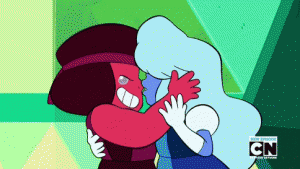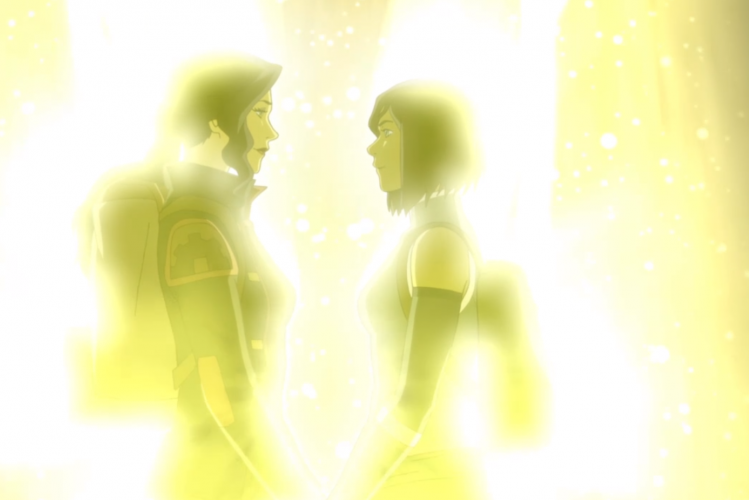December 18, 2014. It was just short of midnight, and the series finale to The Legend of Korra went live earlier than expected. We all knew it was going to be an epic finale, but little did we know how much of a game-changer it was going to be. A lot of us had been rooting for Korra to end up with her good friend Asami, but we knew the likelihood of that was slim to none since there were basically no gay characters in western animation.
It came to about five minutes before the end. Korra was having a gushy conversation with her ex-boyfriend, Mako. Just as I was about to throw my pillow at the computer, the moment passed, and Makorra remained just friends. Then Korra was joined by Asami for a heart-to-heart. This is nice, I thought. It’s not like Bryke could canonize Korrasami even if they wanted to, but at least we get to end the series with a nice female friendship moment.
Wait…are they going on a vacation together? Holding hands? Lovingly gazing into each other’s eyes as the scene fades out? Did we actually just get a Korrasami ending?
And the internet exploded. I remember the excitement, the surprise, the utter disbelief. You’re getting ahead of yourselves, said the nonbelievers, it wasn’t like they kissed or anything. But only hours after the finale, one of the creators of The Legend of Korra confirmed that Korra and Asami were indeed a couple, and there was much celebration. This was the first time in mainstream western animation that a queer couple was featured in a loving, serious relationship. Sure, there may have been gay characters in children’s animation before, but they were usually background or comic relief characters. For example, in the 2012 movie Paranorman, in a sort of gotcha! moment, a stereotypical jock character reveals he has a boyfriend after the movie had set him up to be with a pretty, popular girl. But now that Korra has paved the way for positive LBGTQ representation in animation, other shows are following its lead.
 Take Cartoon Network’s Steven Universe, for example. In March, it was revealed that (spoiler alert) Garnet was actually the representation of a romantic relationship between two female-presenting characters named Ruby and Sapphire. And then on June 26, gay marriage was legalized in the United States. It raises the question: Have people become more receptive to queerness as a result of the media? Will a new generation be raised with less prejudice as a result of shows like Korra and Steven Universe? Does life imitate art?
Take Cartoon Network’s Steven Universe, for example. In March, it was revealed that (spoiler alert) Garnet was actually the representation of a romantic relationship between two female-presenting characters named Ruby and Sapphire. And then on June 26, gay marriage was legalized in the United States. It raises the question: Have people become more receptive to queerness as a result of the media? Will a new generation be raised with less prejudice as a result of shows like Korra and Steven Universe? Does life imitate art?
Some might say it’s the other way around, especially when they see these Anime Portrait Reviews where art literally represents real-life people. And it’s not like showrunners have never tried to include gay characters in kid’s shows before. Princess Bubblegum and Marceline from Adventure Time, according to Marceline’s voice actress Olivia Olson, dated in the past but the show could not portray their relationship. Alex Hirsch, the creator of Disney’s Gravity Falls, also expressed wanting to include gay characters, but hasn’t been able to due to network censors. What might surprise you is that the censors aren’t thinking necessarily of whether showing gay couples would be controversial in America, but whether they would be controversial in other countries that they sell their shows to. Although America still has a long way to go in terms of LBGTQ acceptance, there are other countries that are far worse. Showing gay characters in Russia, for example, could cause an entire network to be banned, therefore causing the show in particular to get cancelled in America, which could cause an entire animation studio to go bankrupt.
But what about Japan? Not only does Japan love American stuff like Steven Universe, but we love their anime. And anime has certainly not been shy about including queer characters over the years. Hell, there are entire genres of anime specifically designed for boys’ and girls’ love. A few shows like Princess Jellyfish and Lovely Complex also portray genderqueer and trans characters in an accepting manner. Of course, just like foreign countries censor our cartoons, we had to censor the HFIL out of anime back in the 90s when society was less accepting of homosexuality. Who could forget the infamous decision to make lovers Sailor Uranus and Neptune cousins in the first American dub of Sailor Moon?
Great job, censors, now they’re incestuous too.
On a surface level, it would seem that Japan is far more progressive than us when it comes to sexuality if we judge solely based off the media.
But here’s the thing: gay marriage is still illegal in Japan. Just like in America, although there is a growing gay community, it is not uncommon, especially amongst older generations, to see attitudes that view queerness as something disgusting and perverted. Although there is positive LBGTQ representation in some anime, there is also negative representation, especially for trans- people in particular. More often than not, characters who dress differently from the gender they are assigned are villains and creeps. Some may argue that some representation is better than no representation, but the trope of “villainish = queer” isn’t helping prominent attitudes that link queerness with deviancy. Anime is a product of Japanese culture, but Japanese culture is not as influenced by anime as much as American “otakus” would probably like to believe.
It’s important to keep in mind that Japanese attitudes towards LBGTQ issues are fundamentally different than American ones, so to define something as “LBGTQ-friendly” or “not LBGTQ-friendly” isn’t my place as a white westerner. I use Japan as an example to show that a handful of instances of positive representation in a medium that greatly influences children does not mean all LBGTQ issues are going to suddenly go away. When people demand more diversity in the media, opponents commonly rebuff their argument as petty. “If you want queer characters so much, why don’t you just write your own story?” But the problem is that stories about queer characters are less likely to get published or get past the censors (this goes for all media with minority characters. Hell, even having a female protagonist is a disadvantage). Representation in children’s media is so important because it shows kids that there are people like them; not just villains and characters to be laughed at, but heroes and friends. Imagine you’re a young woman of color, a tomboy, and bisexual, and the only character that is “like you” is a stereotype on an adult show your parents watch. Then you see The Legend of Korra, and it’s a huge relief. There are tons of queer characters and awesome stories wanting to come out-but first we have to build a kind of world that does not see such a thing as deviant and shameful.
Header image via Nickelodeon/idigitaltimes. Image of Ruby and Sapphire via Steven Universe Wiki. Image of Yaoi via Wikipedia.



